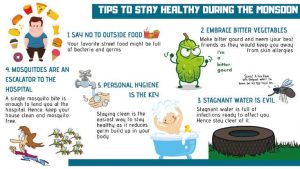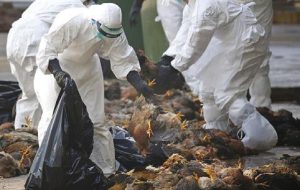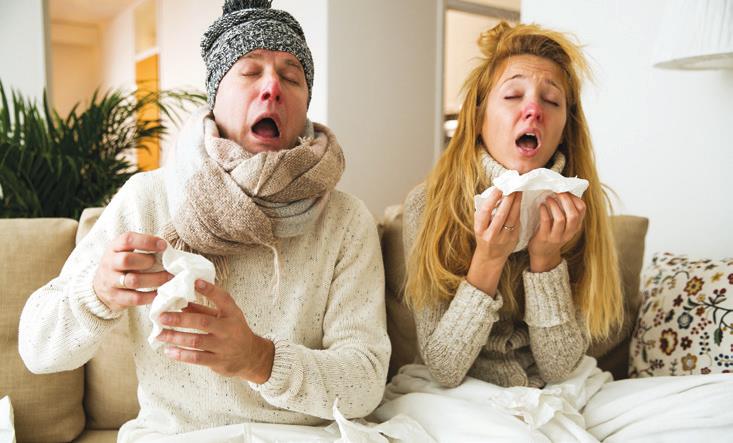Stay Clean and Healthy

You need to on your guard with regard to diseases that spread through air or water and take steps to reduce exposure to the pathogens that cause them. If you follows preventive measures then such potentially life threatening waterborne diseases can be kept at bay.
By Dr Manisha Yadav
 Seasonality is the basic cause of many viral infections of humans, but the mechanisms underlying seasonality, particularly for person-to-person communicable diseases, remain inadequately understood. Better understanding of drivers of seasonality could provide insights into the relationship between the physical environment and infection risk, which is particularly significant in the context of global ecological change in general, and climate change in particular.
Seasonality is the basic cause of many viral infections of humans, but the mechanisms underlying seasonality, particularly for person-to-person communicable diseases, remain inadequately understood. Better understanding of drivers of seasonality could provide insights into the relationship between the physical environment and infection risk, which is particularly significant in the context of global ecological change in general, and climate change in particular.
First, we start with air borne diseases. Many such diseases affect humans. Understanding diseases that spread through the air, and how to prevent and avoid them, is important. There are several treatment options, as well, which people need to know if they catch an airborne disease. Simple measures, such as staying home when sick, reducing contact with people who are sick, and other prevention methods, are also looked.
Airborne diseases are commonly spread by sneezing and coughing, making the diseases difficult to control. Airborne diseases are illnesses spread by tiny pathogens in the air. These can be bacteria, fungi, or viruses, but they are all transmitted through airborne contact. In most cases, an airborne disease is contracted when someone breathes in infected air. And a person also spreads the disease through their breath, particularly by sneezing and coughing, and through phlegm. There are frequent outbreaks of common cold and cough which also need timely attention. Due to intense humidity, skin and scalp infections are common. Often, asthma and arthritis also get aggravated.
 These illnesses, including colds and flu, are transmitted through the air. Many airborne diseases are common and can have mild or severe symptoms. Prevention tips include good ventilation to swap indoor and outdoor air. Ventilation methods, such as opening a window or using fans, help to exchange dirty air. Treatment for less serious airborne diseases includes rest and fluids.
These illnesses, including colds and flu, are transmitted through the air. Many airborne diseases are common and can have mild or severe symptoms. Prevention tips include good ventilation to swap indoor and outdoor air. Ventilation methods, such as opening a window or using fans, help to exchange dirty air. Treatment for less serious airborne diseases includes rest and fluids.
Common airborne diseases
Particles that cause airborne diseases are small enough to cling to the air. They hang on dust particles, moisture droplets, or on the breath until they are picked up. They are also acquired by contact with bodily fluids, such as mucus or phlegm. Once the pathogens are inside the body, they multiply until someone has the disease. Common airborne diseases include
Influenza: The seasonal “flu” virus spreads easily from person to person. There are many strains of the flu, and it continually changes to adapt to the human immune system.
- The common cold: The condition called “a cold” is usually caused by a rhinovirus. There are many rhinoviruses, and the strains change to make it easier to infect humans.
- Varicella zoster: This virus causes chickenpoxand spreads easily among young children. The rash is typically widespread on the body and made up of small red spots that turn into itchy blisters, which scab over in time. Chickenpox is spread for about 48 hours before a rash shows, which is how it infects others so successfully. It is usually spread through the air or by touching the rash.
- Mumps: This virus affects the glands just below the ears, causing swelling and, in some cases, loss of hearing. Vaccination is considered important to prevent the disease.
- Measles: This illness is caused by contact with a person who has the measlesvirus, or by inhaling particles from their sneezes or cough. As with mumps, vaccination is essential for preventing the spread of this disease.
- Whooping cough (pertussis): This is a contagious, bacterial illness that causes the airways to swell. The hacking cough that results is persistent and generally treated with antibioticsearly on to prevent damage.
 Uncommon airborne diseases include:
Uncommon airborne diseases include:
- Anthrax: This is a bacterial disease that infects the body when a person inhales anthrax It causes nausea and flu symptoms. Inhaled anthrax is difficult to diagnose because it resembles other diseases such as flu. Anthrax is treated with antibiotics to stop it worsening.
- Diphtheria: A rare bacterial disease, diphtheriadamages the respiratory system and attacks the heart, kidneys, and nerves. Its rarity may be due to widespread vaccination. Diphtheria can be treated with antibiotics.
- Meningitis: Meningitis swells the membranes around the brain and spinal cord. It is a bacterial or viral infection, but is also caused by an injury or fungal infection. Common symptoms include a persistent headache, fever, and skin rash.
The length of an illness caused by a common airborne disease can vary from a few days to weeks, but it is usually dealt with easily. Uncommon airborne diseases may require additional treatment.
Symptoms
Many airborne diseases have symptoms similar to the common cold or influenza. They include cough chill, muscle and body aches, fatigue, congestion, sneezing, runny or stuffy nose, sore throat, slight body aches or headaches, and sinus pressure. Some people also experience low fever or general sluggishness with these symptoms.
Treatment and outlook
 Airborne diseases are widespread and easily treatable, in most cases. Complete prevention is difficult, but there are some ways to reduce exposure to the pathogens that cause them. Regular hand-washing and other good sanitary habits will help prevent the spread of airborne diseases. Wearing a hospital mask in public, and covering sneezes and coughs with an elbow or tissue, are some of the good habits that are recommended. Regular hand-washing can also help lower the spread of bodily fluids that may contain disease-causing germs. In an unventilated area, pathogens, pollutants, and moisture can build up to unsafe levels. Cleaning the air with a filter is another part of keeping an area as free of pollutants and pathogens as possible.
Airborne diseases are widespread and easily treatable, in most cases. Complete prevention is difficult, but there are some ways to reduce exposure to the pathogens that cause them. Regular hand-washing and other good sanitary habits will help prevent the spread of airborne diseases. Wearing a hospital mask in public, and covering sneezes and coughs with an elbow or tissue, are some of the good habits that are recommended. Regular hand-washing can also help lower the spread of bodily fluids that may contain disease-causing germs. In an unventilated area, pathogens, pollutants, and moisture can build up to unsafe levels. Cleaning the air with a filter is another part of keeping an area as free of pollutants and pathogens as possible.
It is important for people to talk to a doctor as soon as they experience symptoms to avoid any complications and to begin treatment. Symptoms of the common cold can be treated, but the illness tends to go away without treatment. The flu runs its course over a few days before someone starts to recover. In the case of chickenpox, the immune system usually deals with the virus on its own. While airborne diseases are common, serious complications are much rarer and normal vaccinations reduce the risk, substantially.
Water Borne Disease
 According to World Health Organization, every year more than 3.4 million people die as a result of water-related diseases, Most of the victims are young children. Common symptoms include high fever, nausea and vomiting which can become life threatening if ignored.
According to World Health Organization, every year more than 3.4 million people die as a result of water-related diseases, Most of the victims are young children. Common symptoms include high fever, nausea and vomiting which can become life threatening if ignored.
Monsoon is around the corner. The onset of monsoon brings relief from the scorching heat of summer but it also makes one susceptible to a host of waterborne diseases.
The most common waterborne diseases associated with monsoon are Malaria, Jaundice (Hepatitis) and Gastro-intestinal infections such as Typhoid and Cholera. Apart from many biological reasons why these diseases flourish in monsoon, there are some other reasons you should be careful about: overflowing drains, sewage pipe bursts and mix-ups with municipal drinking water lines which contaminate your drinking water.
It is rightly said that prevention is better than cure. If one follows preventive measures then such potentially life threatening waterborne diseases can be kept at bay:
- Avoid wading in rainwater or going out during a heavy downpour. If you must, remember to wash the area of contact with soap and water as soon as possible.
- Personal hygiene can be intensified during this period. You should keep skin clean and dry. Washing hands often throughout the day can spell the difference between prevention and disease.
- Stagnant water is a breeding ground for mosquitoes. Check your living space for any hotspots of contamination eg. air conditioning trays, flowerpots and vases, and choked drains. If there’s a pond near your premises, then breed Gambusia fish as they reduce the chances of mosquito breeding. Alternately, call the municipal authorities for fumigation.
- Use effective mosquito repellant while going out and cover windows with mosquito nets.
- Our digestive system becomes weak during this season so one should avoid eating spicy, fried and junk food as these have heated thermal effect on our bodies and make us feel lethargic and sluggish.
- Keep food covered. Flies look harmless but are carriers of serious waterborne diseases such as typhoid and cholera.
- Drink warm water and strictly avoid untreated water, or water/ice from unknown sources.
- Make the important decision about investing in a home water purifier for the safety of your loved ones; during the monsoon and every day. Consider a water treatment option based on your water quality. UV technologyis an excellent disinfection technology and is ideal for municipal treated and supplied water. When the water is from underground sources such as bore wells and is high in salts/TDS making it hard and unpalatable, consider RO technology.
(Based on a conversation with DR V K Monga Family Physician and Honorary Finance Secretary, IMA Headquarters, New Delhi)

